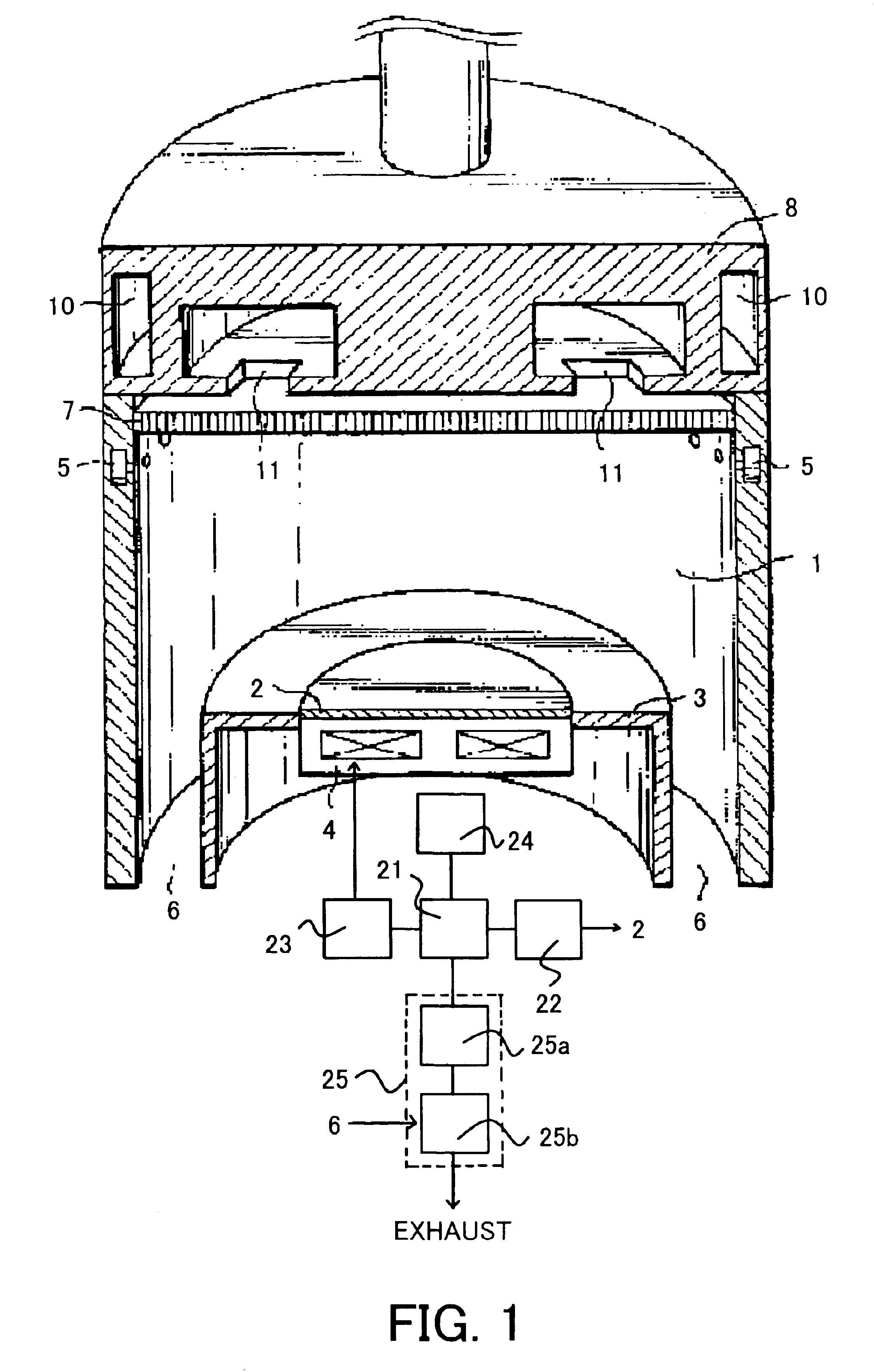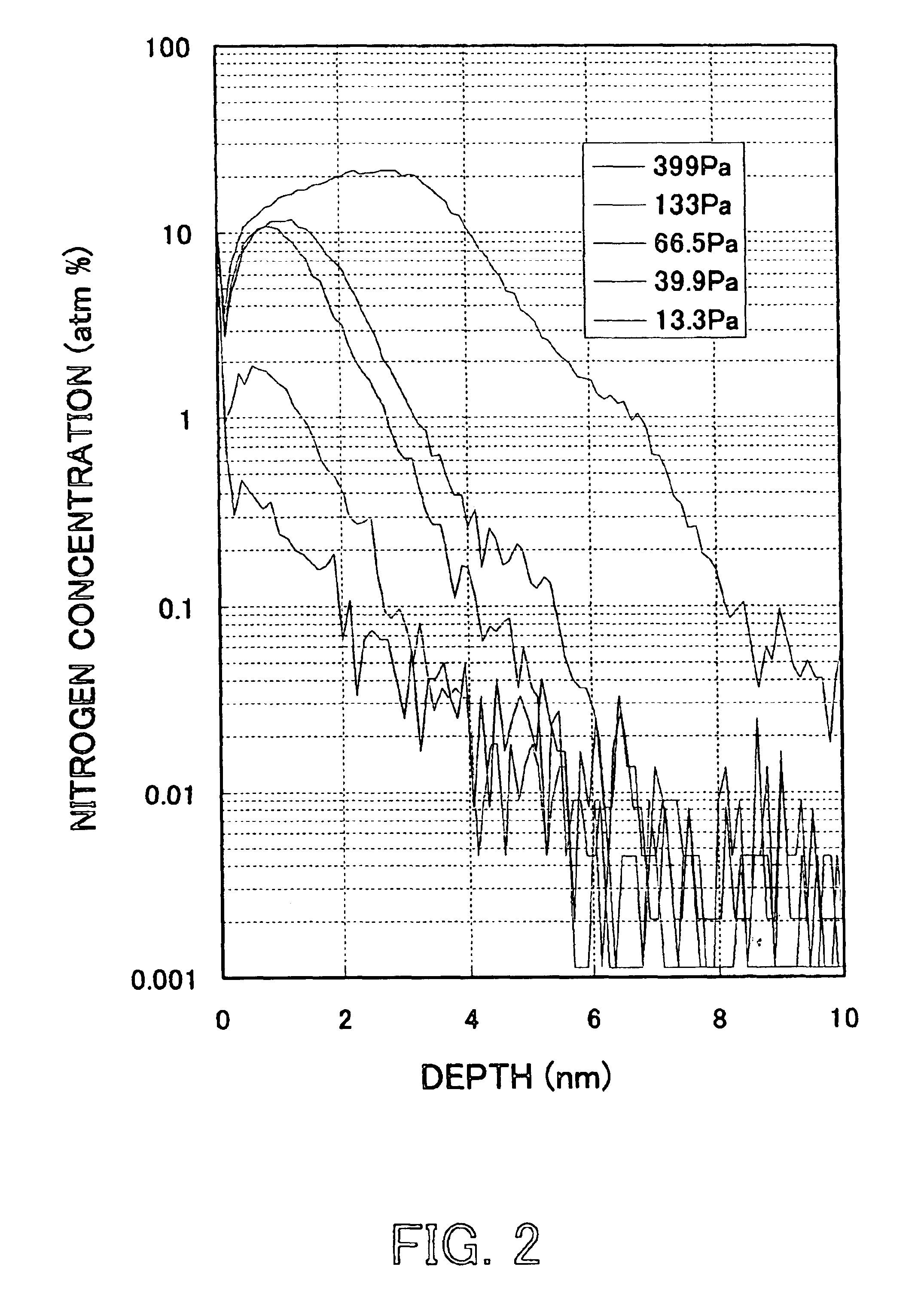Surface modification method
a surface modification and silicon oxide film technology, applied in the field of semiconductor device manufacture methods, can solve the problems of increasing the nitrogen concentration in the interface between silicon and silicon oxide film, nitriding silicon oxide film, not yet being reduced to practice, etc., to achieve rapid surface modification, increase the nitrogen concentration, and reduce the nitrogen concentration
- Summary
- Abstract
- Description
- Claims
- Application Information
AI Technical Summary
Benefits of technology
Problems solved by technology
Method used
Image
Examples
first embodiment
[0042]A description will now be given of a second embodiment according to the present invention, using a microwave surface-wave interference plasma processing apparatus shown in FIG. 1. First, the heater 4 heats the substrate stage 3 up to 200° C., and the substrate 2 that forms a silicon oxide film having a thickness of 2 nm on its surface is fed to and placed on the stage 3. Next, the plasma process chamber 1 is vacuum-exhausted by the exhaust system 25 down to 1 Pa. Then, nitrogen gas is introduced into the plasma process chamber 1 at 500 sccm through the process gas introducing means 5. Then, the pressure regulating valve 25a, such as a conductance valve, provided in the exhaust system 25 is regulated so as to hold the pressure in the plasma process chamber 1 to 133 Pa.
[0043]Then, the microwave power supply (not shown) supplies the plasma process chamber 1 with microwaves of 1.5 kW through the slot-cum non-terminal circle waveguide 8 and dielectric window 7, thereby generating p...
second embodiment
[0045]A description will now be given of a second embodiment according to the present invention, using a microwave surface-wave interference plasma processing apparatus shown in FIG. 1. First, the heater 4 heats the substrate stage 3 up to 200° C., and the substrate 2 that forms a silicon oxide film having a thickness of 2 nm on its surface is fed to and placed on the stage 3. Next, the plasma process chamber 1 is vacuum-exhausted by the exhaust system 25 down to 1 Pa. Then, nitrogen gas is introduced into the plasma process chamber 1 at 500 sccm through the process gas introducing means 5. Then, the pressure regulating valve 25a, such as a conductance valve, provided in the exhaust system 25 is regulated so as to hold the pressure in the plasma process chamber 1 to 26.6 Pa.
[0046]Then, the microwave power supply (not shown) supplies the plasma process chamber 1 with microwaves of 1.5 kW through the slot-cum non-terminal circle waveguide 8 and dielectric window 7, thereby generating ...
third embodiment
[0048]A description will now be given of a third embodiment according to the present invention, using a microwave surface-wave interference plasma processing apparatus shown in FIG. 1. The instant embodiment has an object to provide an effective and quick nitride process by adding inert gas to gas that contains nitrogen, and raising the plasma density by 2 to 3 times.
[0049]The plasma process is conducted using microwave surface-wave interference plasma processing apparatus shown in FIG. 1 as follows: First, the heater 4 heats the substrate stage 3 up to 150° C., and the substrate 2 that forms a silicon oxide film having a thickness of 2 nm on its surface is fed to and placed on the stage 3. Next, the plasma process chamber 1 is vacuum-exhausted by the exhaust system 25 down to 1 Pa. Then, nitrogen gas of 50 sccm and argon of 450 sccm are introduced into the plasma process chamber 1 through the process gas introducing means 5. Then, the pressure regulating valve 25a, such as a conduc...
PUM
| Property | Measurement | Unit |
|---|---|---|
| temperature | aaaaa | aaaaa |
| pressure | aaaaa | aaaaa |
| temperature | aaaaa | aaaaa |
Abstract
Description
Claims
Application Information
 Login to View More
Login to View More - R&D
- Intellectual Property
- Life Sciences
- Materials
- Tech Scout
- Unparalleled Data Quality
- Higher Quality Content
- 60% Fewer Hallucinations
Browse by: Latest US Patents, China's latest patents, Technical Efficacy Thesaurus, Application Domain, Technology Topic, Popular Technical Reports.
© 2025 PatSnap. All rights reserved.Legal|Privacy policy|Modern Slavery Act Transparency Statement|Sitemap|About US| Contact US: help@patsnap.com



